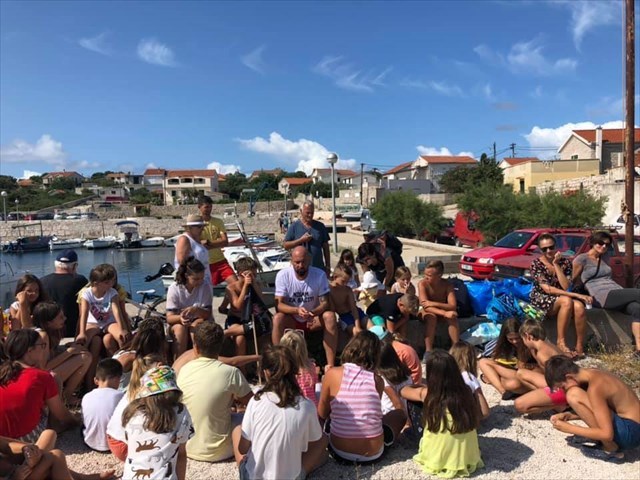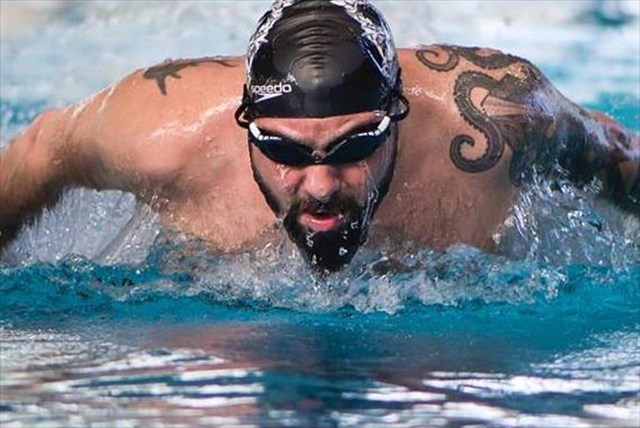
Rok i Ribafish, sin i otac, bili su geocacheri amateri i skupili su preko 300 cacheva sa svih strana svijeta. Imali su plan zajedno posjetiti sve naseljene hrvatske otoke, no njihovu avanturu je prekinula sudbina. Danas, Rok više nije na ovom svijetu, ali tata Ribafish ispunjava obećanje koje mu je dao - da će posjetiti sve hrvatske naseljene otoke, pa stvara Udrugu i projekt #RokOtok, edukacijsko plivački maraton u kojem će kroz tri godine i pedesetak etapa preplivati udaljenosti između svih 50 hrvatskih naseljenih otoka. Ujedno, na svakom otoku će pokušati drugim klincima razviti svijest o važnosti provođenja zajedničkog vremena roditelja i djece kroz sport, druženje, učenje, istraživanje, kao i važnost očuvanja prirode. Geocaching se također promovira kao jedna aktivnost koja odvlači djecu od buljenja u igrice na ekranu prema avanturi, orijentaciji i istraživanju prirode.

Projekt je počeo u ljeto 2019. kad je preplivao preko 100 km spajajući 17 naseljenih otoka u južnom Jadranu. Zbog poznate Covid situacije i ograničenja preskočena je 2020. godina, u ljeto 2021. je projekt nastavljen na Srednjem Jadranu gdje se obišlo 17 novih otoka, dok je ove 2022. godine red došao na Sjeverni Jadran i finalnih 17 naseljenih otoka u Hrvatskoj.
Hrvatski geocacheri su se okupili i napravili “ekološke” cacheve koji će uz prigodnu prezentaciju o geocachingu biti postavljeni na tih 17 otoka. Ovo je jedan od cacheva iz serije.
Za više detalja o projektu #RokOtok posjetite stranicu www.rokotok.hr, a kako je cijeli projekt prilično medijski popraćen, za aktuelne informacije jednostavno izguglajte!

Lošinj
Lošinj je otok na Kvarneru, pruža se 31 km u smjeru sjeverozapad–jugoistok. Značajnija naselja na otoku su Mali i Veli Lošinj. Umjetno je razdijeljen na dva dijela na predjelu Privlaka, gdje je Lošinj najuži. Tu je napravljen kanal. Ovo nije bilo prvo umjetno rezanje Lošinja. U prošlosti su Cres i Lošinj bili jedinstven otok. Tek umjetno prokopanim kanalom kod Osora, vjerojatno u rimsko doba, nastala su dva otoka kako bi se skratio put, odnosno zaobilaženje velike otočne mase na putu za otvoreno more.
Količina morskog otpada svako ljeto raste za čak 40 posto zbog povećanog turizma. Godine 2019. izbio je plastični otpad u morima u prvi plan kada je riječ o zaštiti okoliša. Znanstvenici iz Hrvatske i Italije razvili su model u kojem se morski otpad pretvara u biodizel. To je Projekt MarGnet. Provodi ga se na Lošinju. U ovom projektu biološke sastavnice neće se morati čistiti iz morskog otpada. Aditive će se dodavati zbog učinkovitosti i ISO standarda. Napravljen je prototip koji radi na načelu pirolize na niskim temperaturama koja topi plastiku - i razgrađuje je u goriva. Ovim uređajem se dobije 20 do 30 litara biodizela od 100 kg otpada.

Rok and Ribafish, son and father, were amateur geocachers and they found over 300 caches from all over the world. They had a plan to visit all the inhabited Croatian islands together, but their adventure was interrupted by fate. Today, Rok is no longer in this world, but dad Ribafish fulfills the promise he gave him - that he will visit all Croatian inhabited islands. So, he created the Association and the project #RokOtok (Otok = island in Croatian), an educational swimming marathon in which he will connect all 50 Croatian inhabited islands by swimming, in three years and fifty(ish) stages. At the same time, on each island he will try to educate children and develop their awareness of the importance of spending time with their parents through sports, socializing, learning, research, as well as the importance of nature conservation. Geocaching is also promoted as one activity that distracts children from staring at on-screen games towards adventure, orientation and nature exploration.
The project began in the summer of 2019 when he swam over 100 km connecting 17 inhabited islands in the southern Adriatic. Due to the known Covid situation and restrictions, the year 2020 was skipped, in the summer of 2021 the project continued in the Central Adriatic where 17 new islands were visited, while this year 2022 it was the turn of the Northern Adriatic and the final 17 inhabited islands in Croatia.

Croatian geocachers gathered for this project and made "ecological" caches that will be placed on these 17 islands with a short presentation on geocaching. This is one of the caches from the series.
For more details about the #RokOtok project, visit the page www.rokotok.hr, and as the whole project is quite covered by the media, just google it for current information!
Lošinj
Lošinj is an island in Kvarner, stretching 31 km in the northwest-southeast direction. The most important settlements on the island are Mali and Veli Lošinj. It is artificially divided into two parts in the area of Privlaka, where Lošinj is the narrowest. A channel was made there. This was not the first artificial cutting of Lošinj. In the past, Cres and Lošinj were a single island. Only artificially dug channel near Osor, probably in Roman times, created two islands in order to shorten the way, i.e. to bypass the large island mass on the way to the open sea.
The amount of marine litter increases by as much as 40 percent every summer due to increased tourism. In 2019, plastic waste in the seas came to the fore when it comes to environmental protection. Scientists from Croatia and Italy have developed a model in which marine waste is converted into biodiesel. This is Project MarGnet. It is held on Lošinj. In this project, biological components will not have to be cleaned from marine debris. Additives will be added for efficiency and ISO standards. A prototype was created that works on the principle of pyrolysis at low temperatures, which melts plastic - and breaks it down into fuels. This device produces 20 to 30 liters of biodiesel from 100 kg of waste.
